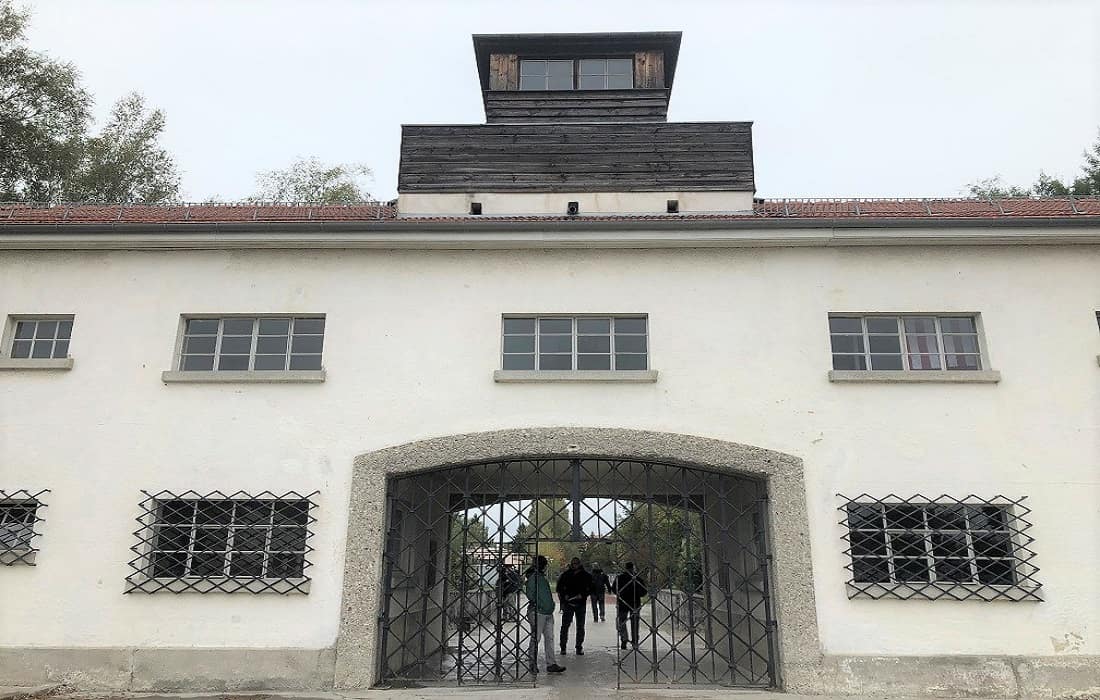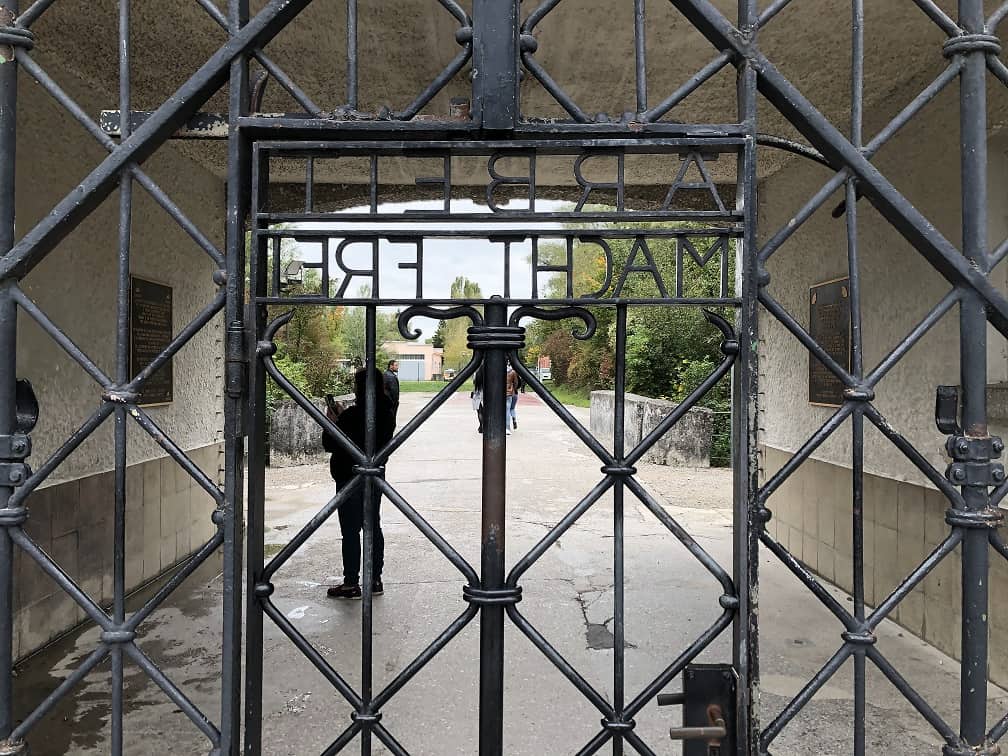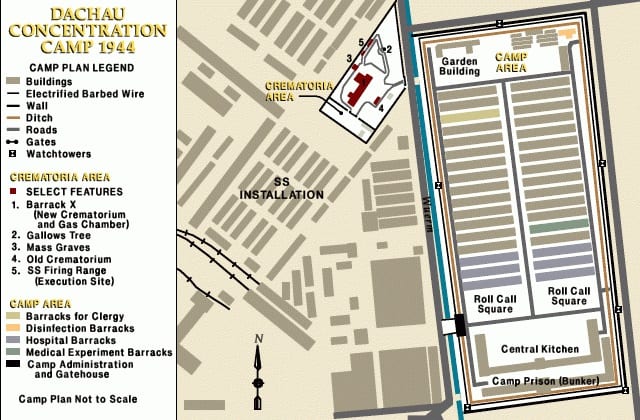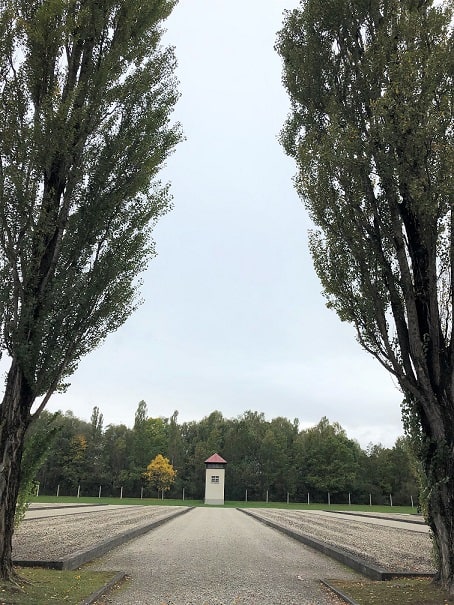Why You Should Visit Dachau Concentration Camp
Visiting the Dachau Concentration Camp in Germany might not be something most people choose to do while on vacation. For some, the mere thought is too much. We attended Oktoberfest in Munich and made a conscious decision to visit.
First, I am a firm believer that to understand the world, you must understand its history. Sometimes, this requires seeing it with your own eyes. I wanted to see firsthand what the concentration camp looks like today.
Secondly, I wanted to see how these death camps are positioned. For example, are they marketed as history? Do they portray an accurate representation of what happened? Do they honor the lives lost? Or is there an inch of pride lurking in the shadows like American Plantations?
Lastly, I wanted to see the location, the surrounding area and experience the grounds.

This post may contain affiliate links. Please read our disclosure and privacy policy for more information.
Dachau Concentration Camp Memorial Site
Some people claim that the Dachau Concentration Camp Memorial Site is exploitation. However, it came to be “on the initiative of and under the surviving prisoners’ plans” who joined the Comité International de Dachau. It is not exploitation; it reminds and informs people of the events under Hilter’s leadership.
The memorial opened to the public in 1965 and welcomes around 900,000 visitors each year.
Should You Visit Dachau Concentration Camp?
Yes, however, you will need a strong stomach to face Dachau. Any visit to the Dachau concentration camp will put you up front and center with the greatest crimes against humanity.
Until you have visited a concentration camp, you will not understand the true depth of the Holocaust. Some people will say that this is a place you should not visit – I’m afraid I have to disagree. Dachau concentration camp is not a tourist attraction; it is a memorial to the thousands of people who died in conditions so disgusting and vile that it is difficult to write about.
Most importantly, a visit to the Dachau concentration camp dispels any myths or attempts to diminish the Holocaust. You only need to be there for five minutes to understand the reality and scope of the lives lost.
Facts About Dachau Concentration Camp
- Dachau opened on 22 March 1933.
- It was initially intended to hold political prisoners.
- The camp evolved to include forced labor provided by the imprisonment of Jews, German and Austrian criminals.
- Dachau also housed foreign nationals from countries that Germany occupied or invaded.
- The Dachau complex included the actual concentration camp, factories, and other facilities spread across 20 acres.
- The facility was a training facility for Nazi SS guards.
- Following the passing of the Nuremberg Laws of 1935, which enabled institutionalized racism. Jehovah’s Witnesses, homosexuals, and emigrants were sent to Dachau for discrimination.
- Dachau was the longest-running concentration camp.
- There were 32,000 documented deaths at the camp. However, some estimate that 200,000 prisoners from more than 30 countries died in the camp.
- The main camp was liberated by U.S. forces on 29 April 1945.
Dachau, by all accounts, was the testing ground for a much larger-scale genocide.
Arriving at Dachau Concentration Camp
I think everybody has seen photographs of the train leading up to the gates of concentration camps. I will be the first to confess conceptually this is not what I imagined.
When you first arrive, you go to the visitor center; it is here where you will start your journey.
You will walk down a path from the visitor center that takes you to the train station’s actual remains and the main entrance, the God-awful gates that anyone would recognize.
Two things struck me as odd. The first one is that as you walk up to the gates, an enchanting river flows beside you, creating the illusion that you are in a park. The second oddity behind the river is a community of two-story row houses occupied to this day. The backyard view is literally a view of the concentration camp. When I tell people about our visit to Dachau, I make a point to tell them that there is a community that lives right next door.
The Gates
As you approach the infamous gates, there is a feeling that comes over you that I can only describe as cold. I do not mean cold in the physical sense. Granted, the day that we visited was not the warmest. I mean, there is real cold soberness that lingers in the air.

The gates read “Arbeit Macht Freiwas”. Translated, this means WORK:
- Makes you free
- Makes one free
- Shall set you free.
However, there is no freedom at Dachau.
Inside Dachau Concentration Camp
Once you get beyond the gates, what may have started as a good day is about to turn into one of the saddest days of your life. For context, Brian only viewed the first prison bunker and then left sick to his stomach.
Once you get into the main courtyard, you can either tour the barracks, the “bunker,” or the camp prison. The barracks are to the left, and the prison cells are to the right. We started by going to the right-hand side to view the prison cells.
The Camp Layout

Dachau Concentration Camp, 1944
Image Courtesy of US Holocaust Memorial Museum
The Prison Cells
Row after row after row after row of seemingly endless prison cells about a queen bed size. A coldness will embroil you as you walk these halls. Many of the cells tell the story of the prisoners that occupied them.
The Courtyard
Following the prison cells, you head to the main courtyard. The first thing you will come across is the rack. It does not take very much study or imagination to understand how this contraption was used.

Human beings were hung in various positions from these contraptions for hours on end in freezing conditions. It is known as the so-called “tree or pole hanging.” There is something undeniably chilling about this contraption. This is where I started to feel death. Even if you try not to imagine what happened, the images come to you vividly. No pictures of the victims are required.
And the courtyard was where prisons would stand in freezing conditions for hours on end during a roll call or prisoners’ count. Just one of many cruel punishments endured.
The Barracks
Dachau consists of 32 barracks, 30 of which were accommodation barracks. The two barrack structures that are there today are replicas that were erected in 1965. Each of the accommodation barracks was designed to hold 200 people. Before the closure, the barracks were holding 2,000 prisoners. In these bunkers, people lived on top of each other, literally sleeping in quarters the coffin’s size. In fact, the sleeping arrangements look like coffins. I wondered if this was deliberate.


The Remains of the Barracks
As you leave the reconstructed barracks, you then walk through the ruins of the original ones. Quite possibly the largest display of inhumanity you will ever see. There is a brick boundary for each barrack, and a stone number identifies the barrack.
There are beautiful trees to lessen the blow. Sadly, as beautiful as the trees are, they do nothing to dimmish the reality of what you are seeing.
The Memorials
There are many memorials at Dachau through the complex. I found the memorials touching. Germany, while she cannot erase her history, she has accepted it. And, most importantly, Germany does not hide or downplay the atrocities. There is no sugarcoating.
Rather, Germany pays respect and uses the opportunity to educate the world. Something Plantations in American should consider.
The Crematorium
At the end of the barrack rows, you get to a bridge crossing the river. Sadly, I had no preparation for what was next.
I would strongly advise you to think about crossing the bridge. Be prepared to see things you cannot “unsee.”
The bridge looks inviting. There is a chapel that is inviting – the irony of it is disgusting. If you cross the bridge, you will witness the gas chambers and the crematoriums.
There are two crematoriums. The original one was too small to handle the volume. Then, the larger version was commissioned to manage the volume of dead bodies.
The gas chambers at Dachau were not used for mass execution. There are varying accounts of the intent, and the most likely one being testing the capability and design of things to follow. And they were used on a small scale purely for execution.
There are no words to describe seeing the crematorium. A picture says it all.

Crimes Committed at Dachau Concentration Camp
Most prisoners met their death from starvation, disease, or torture. Then there are the medical experiments. Hundreds of medical experiments took place here.
If you have not heard of or read about Sigmund Rascher – do so. It was at Dachau that hundreds of people were subjected to medical experiments, often resulting in death.
Some examples of experiments:
- High altitude experiments
- Hypothermia experiments
Getting to Dachau Concentration Camp
Located just 10 miles from Munich, it is easy to get to Dachau. You could drive or take an Uber; however, it is much easier (and cheaper) to take the train and bus.
Purchase a single-person day ticket called “Munich XXL.” This covers all the public transit you need for the day for a 24-hour period.
- Take the S2 train in the direction of Petershausen/Dachau/Altomünster.
- Get off at Dachau.
- Directly outside of the Dachau, there is a bus station.
- Catching the bus to Dachau Concentration Camp
- Board bus 726 in the direction of “Saubachsiedlung.”
- The bus stops directly outside the entrance to the Dachau Concentration Camp Memorial Site.
Getting back is as easy; reverse the route.
Where To Say In Munich
What You Need to Know
- Visiting Dachau Concentration Camp is free.
- You can purchase a guided tour for a few euros.
- Children under the age of 13 can only enter with their parents.
- If you travel with children, there are restrictions. For example, children cannot view some of the films and some of the exhibits.
- The tour requires a lot of walking, mostly on gravel.
- The site spans 20 acres; if you plan to see it all, expect to spend four hours here.
- The visitors center has restrooms and a Cafeteria.
- Paid parking is available at Dachau Concentration Camp.
Closing Thoughts
I will never forget what I saw at Dachau Concentration Camp. I will never understand anyone who still believes or thinks the Holocaust was made up.
If anybody believes that it is made up, they need to take a tour through some of Europe’s concentration camps.
While I learned new historical facts, I left with a heightened sense of appreciation for people’s struggles.
I cannot say that this is for everybody. I found our tour depressing and disturbing. Easy for me to say as a spectator because I did not experience the horrors. However, the whole point of visiting a concentration camp is to pay respect, learn, and remember.
You can visit a museum, and you can watch a movie, read a book or listen to a podcast on the holocaust. Yet, until you have been to an actual concentration camp, I do not think you can fathom the depths of cruelty that racism and genocide caused.
For this reason alone, I recommend that anybody in Germany takes the time to pay their respects to the millions of people who lost their lives during the holocaust.
Looking for more posts on Germany? Start here:
- Inside Hohenschwangau Castle – The Mad Kings Childhood Home
- Inside Neuschwanstein Castle – Germany’s Fairytale Castle
- Linderhof Palace – King Ludwig’s Country Retreat
We participate in the Amazon Services LLC Associates Program, an affiliate advertising program designed to pay us fees for linking to Amazon.com and affiliated sites.
Brit On The Move™ Travel Resources
Ready to book your next trip? Use these resources that work:
Was the flight canceled or delayed? Find out if you are eligible for compensation with AirHelp.
- Book your Hotel: Find the best prices; use Booking.com
- Find Apartment Rentals: You will find the best prices on apartment rentals with Booking.com’s Apartment Finder.
- Travel Insurance: Don’t leave home without it. View our suggestions to help you decide which travel insurance is for you: Travel Insurance Guide.
- Want to earn tons of points and make your next trip accessible? Check out our recommendations for Travel Credit Cards.
- Want To Take A Volunteer Vacation or a Working Holiday? Check out the complete guide to how here!
- Want to Shop For Travel Accessories? Check out our Travel Shop.
Need more help planning your trip? Visit our Resources Page, which highlights the great companies we use for traveling.



I too visited Dachau, in 1978, age 25. We met a survivor of the camp who gathered a group together to tell us his experiences. His words and the place is still in my brain, I remember saying that anyone who travels to or in Europe should visit one of the concentration camps, that everyone should know. I’m 70 now and am still telling people about what I saw.
Hi Anne,
I agree with you – everyone should visit at least one to comprehend the magnitude of suffering. I just went to Auschwitz in Poland. I haven’t had a chance to write about it yet, but it’s much more commercialized than Dachau, which is a shame. This said, I will never forget the chill you feel when you walk into one. I can’t imagine what it was like for you to meet a survivor. And like you, I tell everyone about Dachau. Nikki
Thank you for this incredibly moving description. I plan to take my 16-year-old and you’ve given me a lot to think about.
Hi Lisa,
I am thrilled that you found this moving. And, really glad you are taking your daughter. I have a 13-year old nephew and I plan to take him at some point. It’s probably the best education we can give them on history. It’s very dark so I would recommend some conversations before you go so that your daughter has an idea of what to expect. Thanks for stopping in… Nikki
I visited Dacha a few years ago and walked around in utter disbelief as to the extent of torcher and inhumane conditions individuals had to endure to the end of many who lost their life. The walk around was a sobering chill of cold and disbelief. There were quite a number of visitors on that day and no one had anything to say, ever one just moved around in a very quite and respectable way. A sobering experience. We must never forget.
Hi Lual,
You said it so well, no one has anything to say because it’s so unbelievable. I think I mentioned in the article that my husband had to leave. And, while I do think everyone should see the horror with their own eyes it’s a lot to take in and comprehend. It took a lot to try to be happy after seeing it. Yes – we must never forget. Nikki
I visited there when I was 14, and it made such an impact on me. I remember how quiet everyone was while walking around – it was so somber, but what happened there was awful. I think it’s important to remember things like that so history doesn’t repeat itself. So awful!
Oh gosh, I can’t imagine seeing this at 14 – it had to have left an impact on you. And, I agree it’s important to remember:)
Thank you for the heads up about visiting this place. It is something that’s not on top of my travel list but I agree with you that this trip may be a learning experience and it can help us understand our history. Will definitely consider this should we have a chance to visit Germany again.
Hi there,
I agree this is not on many people’s list. I would go as far as to say maybe only history buffs. If you are there, consider it:) Nikki
Like you, I make a point to visit such places which remind of our terrible past as well. The thing about learning history is that we shouldn’t repeat out mistakes and learning what horrible things happened in the past is important. I’ve been wanting to visit Poland to visit Auschwitz, but I’m yet to find suitable flight tickets! Good to read your account on Dachau concentration camps. I can understand when you try to describe the feeling as you reach the gates – it is hard to digest when you imagine what happened at that very spot years ago. Thanks for this post. I hope to head to Munich and Dachau once the borders open.
Hi there,
Yes! History is the gateway of what not to do. I hope you get the chance to visit :) Nikki
I also love to see historical sites like this, it’s important to face history even when it’s not a bright one. I imagine that seeing the crematoriums must’ve been really difficult, and how terrible it is that they conducted such atrocious experiments on the prisoners. Thanks for your perspective on going to see this site.
Hi Chrissi, yes the crematoriums are a lot to take it. It shocked me as I did not expect those to be on display :(
I totally agree. When I told people I wanted to visit places like Auschwitz, they balked at the idea. Why would I want to visit such an awful place? Holidays are meant to be about doing fun stuff and relaxing. But like you said, in order for us to really understand a place and its people, we should learn its history. We shouldn’t forget the past just because it’s painful. Let it be a lesson and a reminder. I didn’t learn any of that in my history class. So, I try to educate myself through travel.
Hi Ummi,
You are so correct – virtually none of this is taught in school these days. Hence why it’s so important that people learn in person :)
We were Munich for Oktoberfest and didn’t get out of the city. Last year we made it to Auschwitz though and it was just as somber as you describe. Next time I am in Munich I think Dachau will have to be in the itinerary.
Hi there,
Auschwitz is on my list as well, although I will be hard-pressed to find anyone to go with me :( Dachau was too much for the group I was with and it really affected everyone. Nikki
I always stop to think twice before visiting sites like Dachau Concentration Camps. But in the end, we have visited sites around the world that memorialize terrible times in the past. But it is a great way to learn more about the history. And in many sites like this to pay tribute to those that endured. Sites like this sure do make it far more real than books or movies. And those strong feelings are not forgotten.
Me too…… it’s one of those things where you want to go but question the idea. I felt the same about the Colosseum even though that was not even close to what happened in concentration camps. I’m glad you felt the realness of this article, it was difficult to write. Nikki
This place – as melancholic as it is – is going to be high on my list. To witness the atrocities – you definitely need a strong stomach. I loved your virtual tour taking me along the bridge, warning me of the bad things to come like the crematorium and then sharing its history. Kudos to you for having taken us so bravely through this.
Hi there,
Yes if you go be prepared – seriously. There are lots of tears, lots of emotion, and for some, they just have to leave. And, even if you can face it – you’ll get little sleep the night you visit :( Nikki
I greatly appreciate the rawness in recounting your experience. This was greatly informative and emotion-provoking, even though I was not physically there. I stand behind your reasons for visiting, and think I would do the same if I go back to Germany. Remembering is the only way to not let it happen again! Thanks for sharing
Chloe,
Thank you so much! When I thought about how to write this it was important for me to convey what it feels like to witness such a place. I’m glad that came through :) Nikki
Really good Nikki… thank you!
Hi Mitch,
I am glad you liked it:) Tough to write but needed. It’s something the world needs to believe, understand, and learn from. Nikki